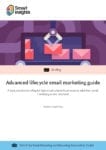Going beyond opens and clicks to evaluate and improve subscriber engagement with your email programmes
 How engaging are your emails? It’s likely that you review open and clickthrough rates for individual email campaigns and newsletters, but can you measure and prove how engaging your email marketing is on a long-term basis across multiple emails starting with the first welcome email. Dan Hare showed that it's challenging - he presented data which shows between 50-90% of subscribers may never open or click in a 6 month period.
How engaging are your emails? It’s likely that you review open and clickthrough rates for individual email campaigns and newsletters, but can you measure and prove how engaging your email marketing is on a long-term basis across multiple emails starting with the first welcome email. Dan Hare showed that it's challenging - he presented data which shows between 50-90% of subscribers may never open or click in a 6 month period.
In this article I’ll show some more advanced techniques we recommend to assess subscriber engagement which go beyond the basic email metrics of delivery, open and clickthrough rates.
Download Expert Member resource – Advanced Lifecycle Email Marketing Guide
A best practices briefing for high email volume businesses to take their email marketing to the next level. This guide is aimed at managers responsible for growing online revenue by integrating different communications channels in larger organisations or businesses that are already fairly sophisticated in their email marketing.
Access the Advanced lifecycle email marketing guide
6 KPIs to Review Email Marketing Engagement
By using these more sophisticated measures to review your emails you will be able to zero in on which aspects of your emails aren’t working and so improve engagement.
1. Engagement with creative.
Let’s start with the obvious short-term engagement with an email communication. This is where it’s common to measure opens and clicks. A good technique here is to combine these measures to look at Click-to-open rate usually abbreviated to CTOR %. This shows the percentage of subscribers who open the email who then clickthrough.You can compare the CTOR metric across campaigns to see how effective your creative, content and calls to action (CTAs) are. Once you have established your benchmark, it’s time to get testing and optimising your CTO rate to drive better engagement with your creative! Try testing your CTA using multiple links for the same action – test out an image, button and inline links, each with different anchor text. Including multiple links has been proven to improve email click-through rates.[Editor's note: If you use Google Analytics, you may want to track clicks from different parts of an email layout using email tracking with analytics, for example by tagging up emails of a certain type, or links in different positions in an email layout, for example header against body of the email, images against text links].
2. Longer-term engagement of subscribers.
Although it’s useful to review open and clickthrough rates, this doesn’t really tell us how engaged our audience is with our communications over a long-time period. Reviewing long-term engagement is a MUCH better measure of the engagement of your email programmes, but many don’t go beyond the headline open and click rates to evaluate this one.To assess long-term engagement, you should measure all subscriber actions which denotes engagement, such as an open, click, download, social share or comment or purchase over a defined longer time period such as a quarter, six months or a year. You can then assess the percentage of your subscribers on your list who are active, for example 70% of subscribers have interacted within the last 6 months. You can set targets to improve engagement by assessing which segments are active in the longer term.
3. Lifecycle engagement.
The longer-term engagement I have talked about will depend on engagement at each stage of the customer lifecycle. For example, you will find that engagement will tend to be higher when you first add subscribers to your database and you send them emails as part of your welcome strategy. So it’s important to keep tracking email engagement as you send additional types of emails to your database such as campaign, product and email newsletters. In this download explaining how to develop conversations, not campaigns, we describe how you should think about your lifecycle emails as conversations. So they’re not just one-way “blasts”, but instead involve delivering more relevant content based on what people click on. A tip we advise here is to target your audience with dynamic content to feature specific categories or products that interest has been shown on by previous clicks on emails or by categories on a website.You will typically find that subscribers become less engaged through time on a list and you will want to measure this and consider techniques such as win back or reactivation campaigns to increase engagement.
4. Profile or demographic segment engagement.
As you develop conversations through the customer lifecycle, you will naturally find that your content and offers appeal more to some customer segments than others. To find out how, you should report on engagement or response among different demographic groups of recipients. For example, consumer email marketers may find that their newsletters work best at engaging male or female audiences or audiences of different ages.Business-to-business marketers may find that the emails work best with readers in certain industries or for different buyer personas. In this case you may want to adjust the content to reference the interests of the group you’re not serving so well based on their response. Alternatively create additional more engaging emails specifically for less responsive segments!
5. Behaviour or category or product engagement.
Although you will get useful insights on which demographics are viewing or clicking on your emails to help make them more customer-centred, it’s arguably even more important to see which types of propositions or offers that your audience are most interested in. Which product categories or individual products are they most interested in? This may give opportunities to improving merchandising and follow-up. A simple example is, if one-specific content or offer is getting the most clicks, then you can make that offer more prominent in future emails or even create a specific email targeting interest in that offer.
6. Technology or platform engagement.
Finally and in my view, least important, remember that you can also segment by different platforms to see which your emails are most effective experiences on in a similar way in which to which we use web analytics. With mobile devices increasing in importance for reading emails you may want to check that your messages are sufficiently engaging when read on tablet or especially smartphone devices with lower resolutions than desktop.Also, check engagement on different webmail platforms such as Gmail, Yahoo! Mail or Outlook. Check that you don’t have a lower level of engagement on some devices which will need fixing.
So, you can see that there are a lot of different methods to review email engagement which should hopefully give you more insight to create more relevant emails which translate into better results. This is what really counts!
To check whether more engaging emails are translating into better commercial returns, the final tip I will give is to review revenue per email across all the different types of emails and segments we have covered. If you don’t sell direct online, so can’t evaluate using revenue, devise a measure which is a proxy for value showing progression in purchase intent such as number of downloads or views of products or where to buy pages.








